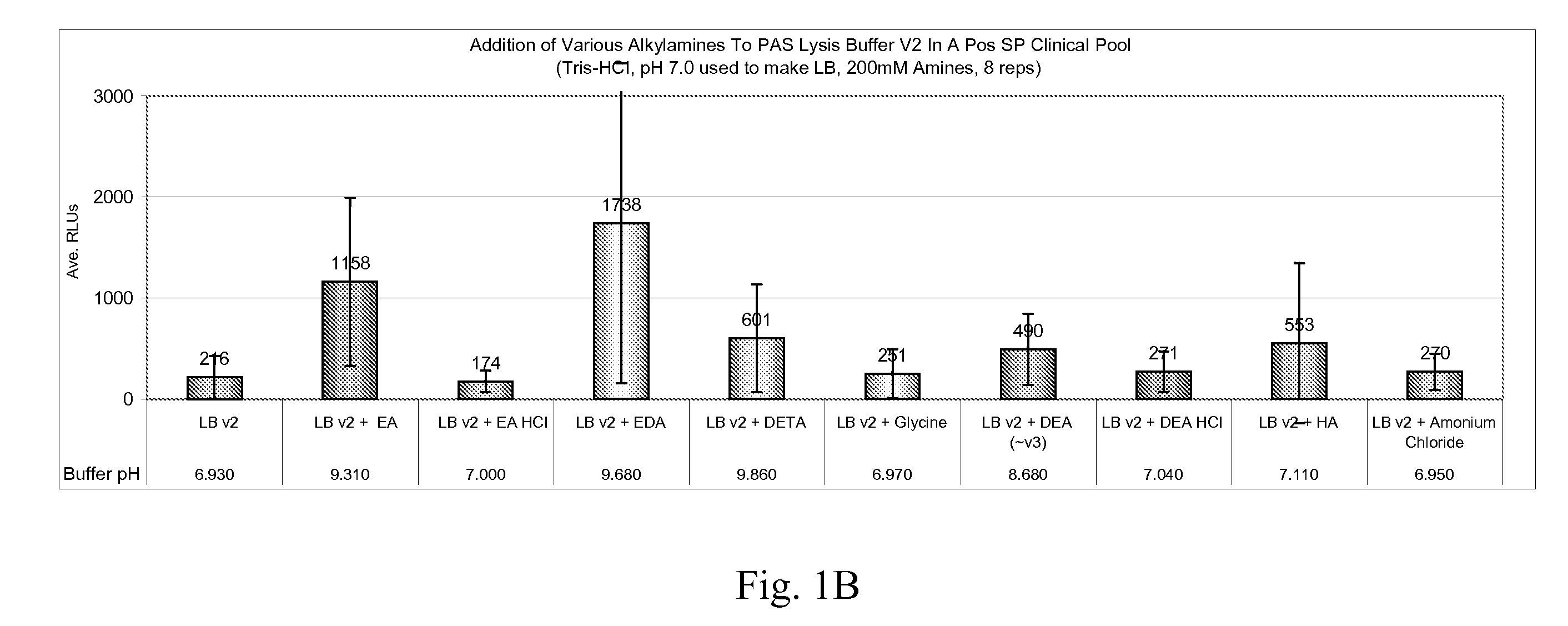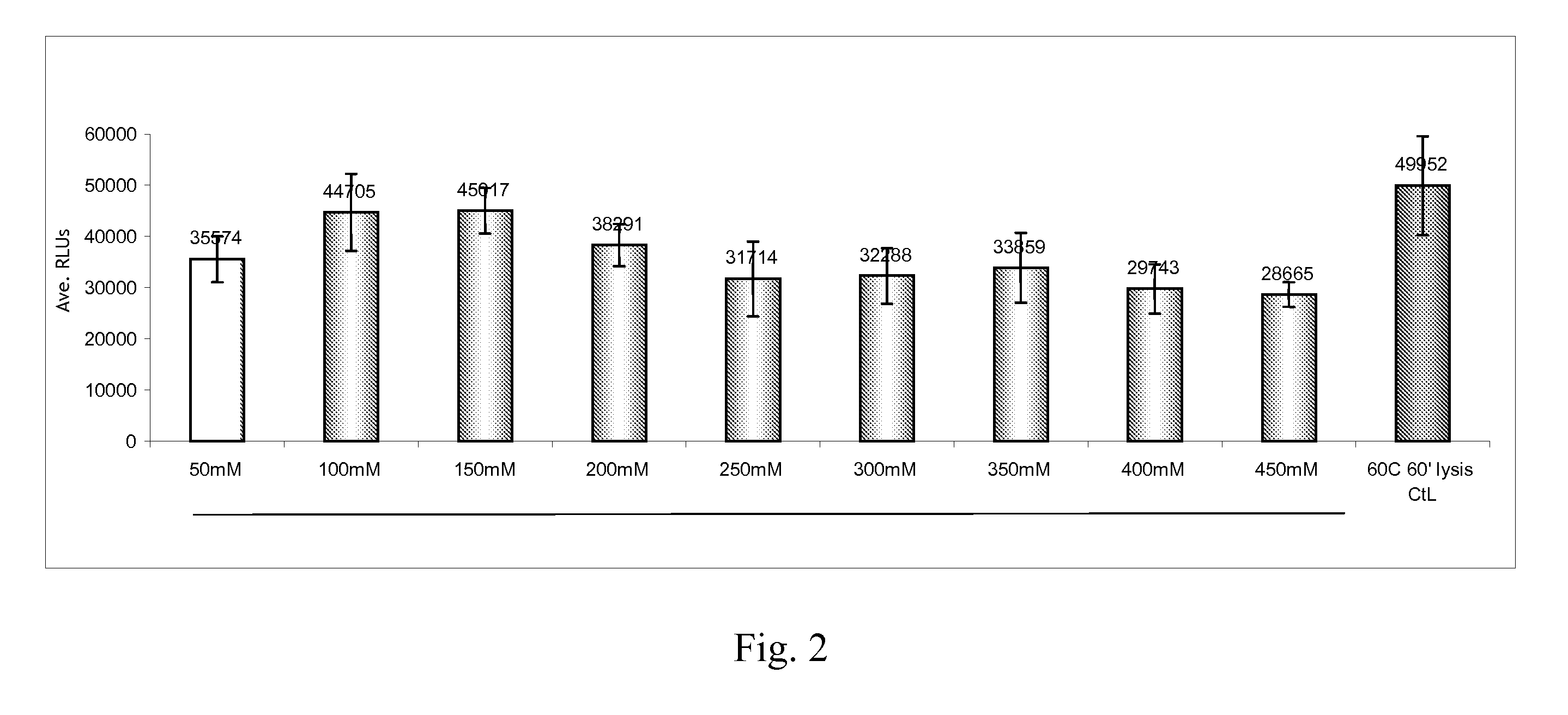Compositions and methods for recovery of nucleic acids or proteins from tissue samples fixed in cytology media
- Summary
- Abstract
- Description
- Claims
- Application Information
AI Technical Summary
Benefits of technology
Problems solved by technology
Method used
Image
Examples
example 1
[0052]This following example shows the effect of various lysis solutions on the yield and signal sensitivity of HPV DNA isolated from aldehyde-fixed clinical cervical samples.
[0053]Clinical cervical samples were collected and fixed in SUREPATH fixative. The fixed samples were then washed and suspended in a lysis solution (“LB”) of: (1) 3% (v / v) Brij-58, and (2) 150 mM Tris-HCl. An additional amine selected from the following group was added to test samples at a concentration of 200 mM: diethanolamine (“DEA”), triethanolamine (“TEA”), TEA-HCl, triethylamine (“TE”), DEA plus indium (III) chloride (“IC”), dicyandiamide (“DC”), DEA plus magnesium perchlorate (“Mg(ClO4)2”); hexamethylene-tetramine (“HMTA”), DEA plus palladium (II) acetate (“PA”), diethylenetriamine (“DETA”), ethylenediamine (“EDA”), glycine, hydroxylamine (“HA”), and ammonium chloride. Typically, 1.5 mL of the sample is added to 1 mL of lysis buffer, plus 25 μl of Proteinase K (10 mg / ml stock) and 60 μl of 1.5% (v / v) Axp...
example 2
[0056]This example shows the effect that varying the concentration of Tris has on the increased efficiency of lysis solution comprising both Tris and diethanolamine.
[0057]Analysis was performed in substantially the same was as in Example 1, except the lysis solution comprised (1) 3% (v / v) Brij-58; (2) 300 mM diethanolamine; and (3) Tris at a concentration selected from 50 mM, 100 mM, 150 mM, 200 mM, 250 mM, 300 mM, 350 mM, 400 mM, and 450 mM. Typically, 1.5 mL of the sample is added to 1 mL of lysis buffer, plus 25 μl of Proteinase K (10 mg / ml stock) and 60 μl of 1.5% (v / v) AxpH™ DNA-affinity magnetic beads to lyse. The lysis solution comprising 50 mM TRIS was selected as a baseline for analysis. Results are shown in FIG. 2 and below at Table 4. Shaded cells in Table 4 indicate replicates having an RLU / CO of greater than or equal to 110.
TABLE 4
example 3
[0058]This example shows the effect of varying the pH on the sensitivity efficiency of nucleic acid lysis solutions comprising both TRIS and diethanolamine.
[0059]Analysis was performed in substantially the same way as in Example 1, except the lysis solution comprised (1) 3% (v / v) Brij-58; (2) 300 mM diethanolamine; and (3) 150 mM Tris. Typically, 1.5 mL of the sample is added to 1 mL of lysis buffer, plus 250 of Proteinase K (10 mg / ml stock) and 600 of 1.5% (v / v) AxpH™ DNA-affinity magnetic beads to lyse. The pH of the lysis solution was adjusted to a value of 7.077, 7.397, 8.113, 8.492, 9.021, 9.265, and 9.443. Results are shown in FIG. 3 and Table 5. Shaded cells in Table 5 indicate individual replicates with an RLU / CO of greater than or equal to 2.00. As can be seen, increasing the pH value of the lysis solution increased the sensitivity of HPV DNA detection.
TABLE 5
PUM
| Property | Measurement | Unit |
|---|---|---|
| Fraction | aaaaa | aaaaa |
| Molar density | aaaaa | aaaaa |
| Molar density | aaaaa | aaaaa |
Abstract
Description
Claims
Application Information
 Login to View More
Login to View More - R&D
- Intellectual Property
- Life Sciences
- Materials
- Tech Scout
- Unparalleled Data Quality
- Higher Quality Content
- 60% Fewer Hallucinations
Browse by: Latest US Patents, China's latest patents, Technical Efficacy Thesaurus, Application Domain, Technology Topic, Popular Technical Reports.
© 2025 PatSnap. All rights reserved.Legal|Privacy policy|Modern Slavery Act Transparency Statement|Sitemap|About US| Contact US: help@patsnap.com



